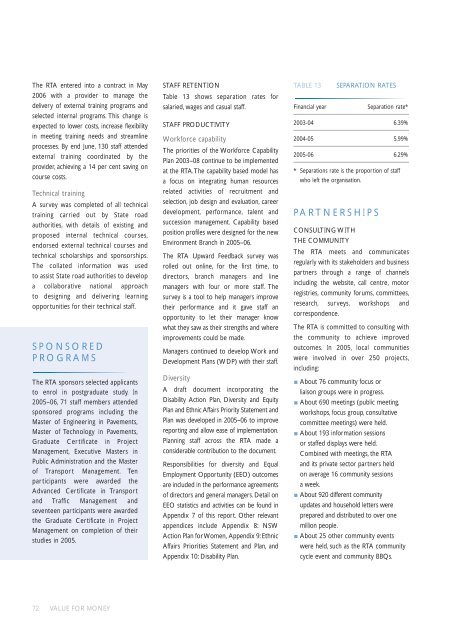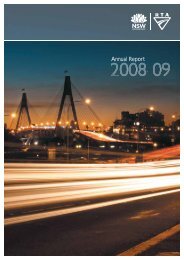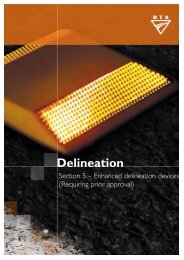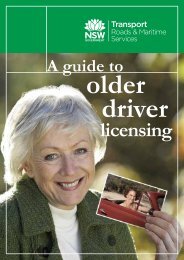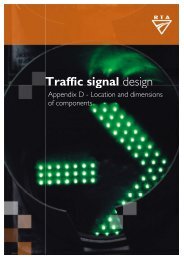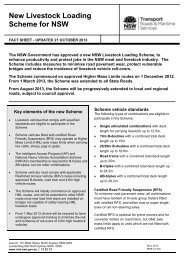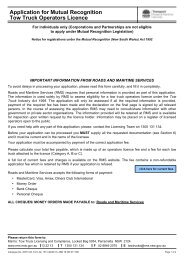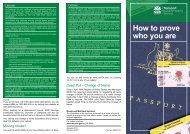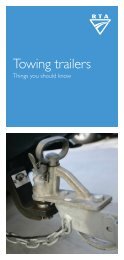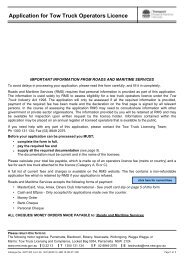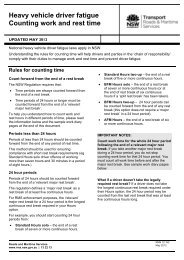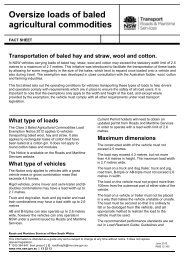Annual Report 2006 (main body) - RTA - NSW Government
Annual Report 2006 (main body) - RTA - NSW Government
Annual Report 2006 (main body) - RTA - NSW Government
You also want an ePaper? Increase the reach of your titles
YUMPU automatically turns print PDFs into web optimized ePapers that Google loves.
The <strong>RTA</strong> entered into a contract in May<br />
<strong>2006</strong> with a provider to manage the<br />
delivery of external training programs and<br />
selected internal programs. This change is<br />
expected to lower costs, increase flexibility<br />
in meeting training needs and streamline<br />
processes. By end June, 130 staff attended<br />
external training coordinated by the<br />
provider, achieving a 14 per cent saving on<br />
course costs.<br />
Technical training<br />
A survey was completed of all technical<br />
training carried out by State road<br />
authorities, with details of existing and<br />
proposed internal technical courses,<br />
endorsed external technical courses and<br />
technical scholarships and sponsorships.<br />
The collated information was used<br />
to assist State road authorities to develop<br />
a collaborative national approach<br />
to designing and delivering learning<br />
opportunities for their technical staff.<br />
SPONSORED<br />
PROGRAMS<br />
The <strong>RTA</strong> sponsors selected applicants<br />
to enrol in postgraduate study. In<br />
2005–06, 71 staff members attended<br />
sponsored programs including the<br />
Master of Engineering in Pavements,<br />
Master of Technology in Pavements,<br />
Graduate Certificate in Project<br />
Management, Executive Masters in<br />
Public Administration and the Master<br />
of Transport Management. Ten<br />
participants were awarded the<br />
Advanced Certificate in Transport<br />
and Traffic Management and<br />
seventeen participants were awarded<br />
the Graduate Certificate in Project<br />
Management on completion of their<br />
studies in 2005.<br />
STAFF RETENTION<br />
Table 13 shows separation rates for<br />
salaried, wages and casual staff.<br />
STAFF PRODUCTIVITY<br />
Workforce capability<br />
The priorities of the Workforce Capability<br />
Plan 2003–08 continue to be implemented<br />
at the <strong>RTA</strong>.The capability based model has<br />
a focus on integrating human resources<br />
related activities of recruitment and<br />
selection, job design and evaluation, career<br />
development, performance, talent and<br />
succession management. Capability based<br />
position profiles were designed for the new<br />
Environment Branch in 2005–06.<br />
The <strong>RTA</strong> Upward Feedback survey was<br />
rolled out online, for the first time, to<br />
directors, branch managers and line<br />
managers with four or more staff. The<br />
survey is a tool to help managers improve<br />
their performance and it gave staff an<br />
opportunity to let their manager know<br />
what they saw as their strengths and where<br />
improvements could be made.<br />
Managers continued to develop Work and<br />
Development Plans (WDP) with their staff.<br />
Diversity<br />
A draft document incorporating the<br />
Disability Action Plan, Diversity and Equity<br />
Plan and Ethnic Affairs Priority Statement and<br />
Plan was developed in 2005–06 to improve<br />
reporting and allow ease of implementation.<br />
Planning staff across the <strong>RTA</strong> made a<br />
considerable contribution to the document.<br />
Responsibilities for diversity and Equal<br />
Employment Opportunity (EEO) outcomes<br />
are included in the performance agreements<br />
of directors and general managers. Detail on<br />
EEO statistics and activities can be found in<br />
Appendix 7 of this report. Other relevant<br />
appendices include Appendix 8: <strong>NSW</strong><br />
Action Plan for Women, Appendix 9:Ethnic<br />
Affairs Priorities Statement and Plan, and<br />
Appendix 10: Disability Plan.<br />
TABLE 13 SEPARATION RATES<br />
Financial year<br />
Separation rate*<br />
2003-04 6.39%<br />
2004-05 5.99%<br />
2005-06 6.29%<br />
* Separations rate is the proportion of staff<br />
who left the organisation.<br />
PARTNERSHIPS<br />
CONSULTING WITH<br />
THE COMMUNITY<br />
The <strong>RTA</strong> meets and communicates<br />
regularly with its stakeholders and business<br />
partners through a range of channels<br />
including the website, call centre, motor<br />
registries, community forums, committees,<br />
research, surveys, workshops and<br />
correspondence.<br />
The <strong>RTA</strong> is committed to consulting with<br />
the community to achieve improved<br />
outcomes. In 2005, local communities<br />
were involved in over 250 projects,<br />
including:<br />
About 76 community focus or<br />
liaison groups were in progress.<br />
About 690 meetings (public meeting,<br />
workshops, focus group, consultative<br />
committee meetings) were held.<br />
About 193 information sessions<br />
or staffed displays were held.<br />
Combined with meetings, the <strong>RTA</strong><br />
and its private sector partners held<br />
on average 16 community sessions<br />
a week.<br />
About 920 different community<br />
updates and household letters were<br />
prepared and distributed to over one<br />
million people.<br />
About 25 other community events<br />
were held, such as the <strong>RTA</strong> community<br />
cycle event and community BBQs.<br />
72 VALUE FOR MONEY


